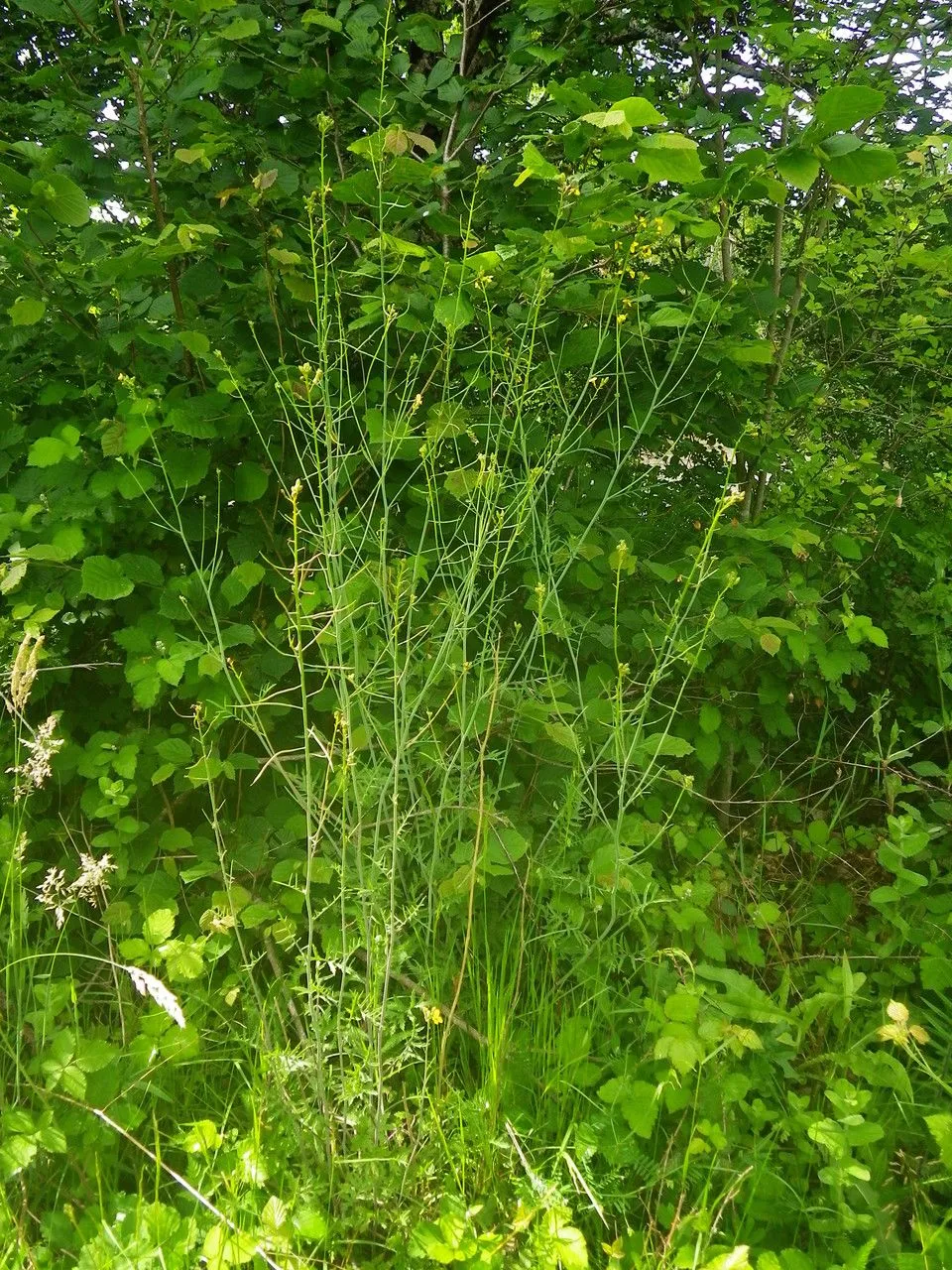
Author: L.
Bibliography: Sp. Pl.: 659 (1753)
Year: 1753
Status: accepted
Rank: species
Genus: Sisymbrium
Vegetable: False
Observations: SE. & E. Europe to Siberia and W. Himalaya
Tumble mustard, known scientifically as Sisymbrium altissimum, is a remarkable plant species belonging to the Brassicaceae family, commonly known as the mustard family. The plant was first described in the notable work Species Plantarum in 1753 by the renowned botanist Carl Linnaeus, often cited simply as “L.”
This annual or biennial herb is notable for its ability to thrive in a variety of habitats, particularly disturbed soils and ruderal areas. Its native range spans southeastern and eastern Europe, extending through Siberia and reaching into the western Himalayas. This wide distribution illustrates the plant’s adaptability and resilience under diverse climatic conditions.
Tumble mustard derives its common name from its fascinating seed dispersal mechanism. Once the plant matures, it dries up and breaks away from its roots, forming a tumbleweed that is carried away by the wind. This motion effectively spreads its seeds over a wide area, ensuring the proliferation of the species across expansive terrains.
The plant can reach an impressive height, often towering above other vegetation. It features finely divided leaves and produces small, yellow flowers arranged in racemes, typical of many members of the Brassicaceae family. These flowers eventually give way to slender seed pods, further contributing to the plant’s effective reproductive strategy.
Ecologically, Sisymbrium altissimum plays an essential role in its native and introduced regions, offering both benefits and challenges. While it can act as a colonizer in disturbed soils, helping to prevent erosion and stabilize the ground, it can also become invasive, outcompeting local flora and altering native plant communities.
Despite its robust nature, tumble mustard carries its charm through its subtle yellow blooms and intriguing lifecycle. Its presence in various ecosystems underscores the dynamic interplay between species and their environments, highlighting the complex yet fascinating tapestry of plant life on Earth.
Understanding and studying Sisymbrium altissimum not only enriches our knowledge of plant ecology but also informs better management practices for ecosystems where it may become overly prolific. This delicate balance between appreciation and control continues to shape our interaction with this resilient and widespread species.
Swe: anis, fänkål, sommarmalört, storbladig murgröna, tordylium, hamnsenap
Lit: aukštoji pikulė
Dan: enårig malurt, irsk vedbend, stor skjoldfrø, ungarsk vejsennep, ægte anis
Fra: grand vélar, sisymbre élevé, moutarde roulante, sisymbre très haute
Deu: hohe rauke, hohe rauke, ungarische rauke, ungarische rauke
Nld: hongaarse raket
Eng: jim hill mustard, tall hedge-mustard, tall mustard, tall rocket, tall sisymbrium, tall tumblemustard, tumble mustard, tumblemustard, tumbleweed, tumbleweed mustard, tall tumble mustard, tall hedge mustard, tumbling mustard
Pol: stulisz pannoński
Lav: augst
Ces: hulevník vysoký
Est: suur unilook
Cym: berwr treigledol, roced dal
En: Tumble mustard, Tumbleweed, Tall mustard, Tall rocket, Tall sisymbrium, Tall tumblemustard, Jim Hill mustard, Tall hedge-mustard, Tumblemustard, Tumbleweed mustard, Tall tumble mustard, Tumbling Mustard, Tall hedge mustard
Cs: Hulevník vysoký
Da: Enårig malurt, Irsk vedbend, Stor skjoldfrø, Ungarsk vejsennep, Ægte anis
Nl: Hongaarse raket
Et: Suur unilook
Fr: Grand Vélar, Sisymbre élevé, Moutarde roulante, Sisymbre très haute, Sisymbre fausse moutarde
De: Ungarische Rauke, Hohe Rauke, Hohe Rauke, Ungarische Rauke, Riesen-Rauke
It: Erba-cornacchia altissima
Lv: Augst
Lt: Aukštoji pikulė
Pl: Stulisz pannoński
Sv: Hamnsenap, Anis, Fänkål, Sommarmalört, Storbladig murgröna, Tordylium
Cy: Berwr Treigledol, Roced Dal
© copyright of the Board of Trustees of the Royal Botanic Gardens, Kew.
© copyright of the Board of Trustees of the Royal Botanic Gardens, Kew.
© copyright of the Board of Trustees of the Royal Botanic Gardens, Kew.
Taken Jun 14, 2016 by Tela Botanica − Sylvain PIRY (cc-by-sa)
Taken Jun 14, 2016 by Tela Botanica − Sylvain PIRY (cc-by-sa)
Taken Nov 4, 2015 by EOL − ellen hildebrandt (cc-by-nc)
Taken Apr 16, 2015 by EOL − Cailin O’Connor Fitzpatrick (cc-by-nc)
Taken Jun 14, 2016 by Tela Botanica − Sylvain PIRY (cc-by-sa)
Taken Jun 2, 2019 by Mari Müller (cc-by-sa)
Taken Nov 3, 2009 by EOL − Barry Breckling (cc-by-nc-sa)
Taken Jun 2, 2019 by Mari Müller (cc-by-sa)
Taken Jun 14, 2016 by Tela Botanica − Sylvain PIRY (cc-by-sa)
Taken May 12, 2021 by Nico Enthoven (cc-by-sa)
Taken Jun 17, 2014 by Tela Botanica − Bruno MACÉ (cc-by-sa)
Taken Jun 4, 2020 by Christine stewart (cc-by-sa)
Taken Jun 6, 2022 by stevensmith2048 (cc-by-sa)
Taken Apr 15, 2018 by Chiara Polla (cc-by-sa)
Taken Jun 18, 2022 by jer (cc-by-sa)
Taken Aug 15, 2018 by Photoflora – Jean-Luc TASSET (©)
Taken Sep 1, 2014 by EOL − Zoya Akulova (cc-by-nc)
Taken Jun 14, 2016 by Tela Botanica − Sylvain PIRY (cc-by-sa)
Taken Jun 14, 2016 by Tela Botanica − Sylvain PIRY (cc-by-sa)
Taken Jun 14, 2016 by Tela Botanica − Sylvain PIRY (cc-by-sa)
Taken May 15, 2016 by Photoflora – Benoit BOCK (©)
Taken Jul 15, 2014 by Photoflora – Benoit BOCK (©)
Taken Jan 1, 1970 by Photoflora – L’Abbé COSTE (©)
Taken Aug 15, 2008 by Photoflora – Jean-Luc TASSET (©)
Taken Aug 15, 2005 by Photoflora – Jean-Luc TASSET (©)
Taken May 15, 2009 by Photoflora – Benoit BOCK (©)
Taken May 15, 2016 by Photoflora – Benoit BOCK (©)
Taken Jan 1, 1900 by EOL − John Hilty (cc-by-nc)
Growth habit: Forb/herb
Ph maximum: 7.5
Ph minimum: 7.0
Light: 8
Atmospheric humidity: 4
Bloom months: [‘may’, ‘jun’]
Soil nutriments: 6
Family: Myrtaceae Author: (F.Muell.) K.D.Hill & L.A.S.Johnson Bibliography: Telopea 6: 402 (1995) Year: 1995 Status:…
Family: Rubiaceae Author: Pierre ex A.Froehner Bibliography: Notizbl. Bot. Gart. Berlin-Dahlem 1: 237 (1897) Year:…
Family: Sapindaceae Author: Koidz. Bibliography: J. Coll. Sci. Imp. Univ. Tokyo 32(1): 38 (1911) Year:…
Family: Asteraceae Author: A.Gray Bibliography: Pacif. Railr. Rep.: 107 (1857) Year: 1857 Status: accepted Rank:…
Family: Fabaceae Author: Medik. Bibliography: Vorles. Churpfälz. Phys.-Ökon. Ges. 2: 398 (1787) Year: 1787 Status:…
Family: Aspleniaceae Author: (Cav.) Alston Bibliography: Bull. Misc. Inform. Kew 1932: 309 (1932) Year: 1932…